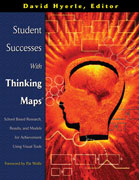



 dent Successes With Thinking Maps®
dent Successes With Thinking Maps®David Hyerle, editor with Sarah Curtis and Larry Alper co-editors
Chapter 14: The Singapore Experience: Student Centered Fluency
Ho Po Chun
“In a knowledge-based economy, information is abundant. What made one person more successful than the other was not the information alone, but rather how effectively he made use of the information. Therefore, our program is designed to prepare the pupils for the economy of the future.”
Teacher
“In Composition, using the Multi-Flow Map helps me look at the bigger picture.”
“Thinking Maps help me expand my vocabulary.”
“Thinking Maps help me keep to the point—no ‘straying.’”
“The use of Thinking Maps help me save time.”
“My vocabulary has improved after using Thinking Maps.”
Various Students
There is something powerful as well as subtle about this common visual language for learning that transcends other models of thinking and best practices. We have found that these tools are not bound by language or culture. There were some initial concerns voiced by some principals that the Mother Tongue (Chinese, Tamil, Malay) teachers would not adapt to the use of thinking maps as well as the other subject teachers. Just the opposite transpired. We see examples all the time of Chinese characters and other languages embedded naturally within the patterns of thinking represented in the maps. For example, a student has created a multi-flow map showing the causes and effects of throwing things from tall buildings (Figure 14.3), a real concern in Singapore since many families live in high-rise apartment buildings. These second language, Mother Tongue teachers have surpassed all expectations by demonstrating how innovative and creative they are in integrating the maps into their lessons.
We believe that this is because the cognitive patterns such as sequencing, categorization, and analogies are universal processes of humankind and of the human mind. The visual maps become a common reference point for communicating, expressing, and uniting thought and language. In a country such as Singapore, where East has met West, our island culture may be best understood as an embodiment of layers of languages and cultures from generations. We need common tools such as thinking maps that help us communicate through the often impenetrable barriers of language and culture that have the potential of separating us. There may be a lesson here for every country at the beginning of the twenty-first century. We, as global citizens, are increasingly in need of common ways of communicating as our world becomes ever more connected and globalized, as technologies web us together, and as we seek to find common ground through understanding about how different people think around the world. As many have said, we may have much more in common than we think.
Read the complete chapter in the book Student Successes With Thinking Maps. Key sections from the chapter The Singapore Experience: Student Centered Fluency with excerpts above include:
- Thinking Maps Implementation: Student-Centered Training
- Student Workshops
- Teacher Training
- Thought and Languages
 Ho Po Chun, M.Ed. is a former teacher and elementary principal in the Singapore schools. Presently she leads the implementation of Thinking Maps for the Innovative Learning Circle in Singapore and is dedicated to developing the thinking abilities of students across Singapore.
Ho Po Chun, M.Ed. is a former teacher and elementary principal in the Singapore schools. Presently she leads the implementation of Thinking Maps for the Innovative Learning Circle in Singapore and is dedicated to developing the thinking abilities of students across Singapore.
![]() Click here (pdf file) to download Research Highlights from
Click here (pdf file) to download Research Highlights from
Student Successes With Thinking Maps
For more on Student Successes With Thinking Maps go to the following links: